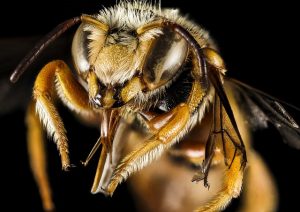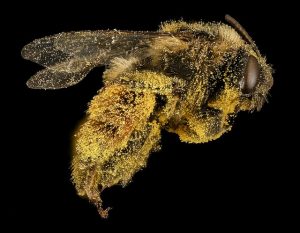Engineer a Bee
Activity from Day 4 of the National Park Service’s Biodiversity – Bee Week activity guide for middle school students. See Scaling and Extension activities at the end for links to hand pollinator design challenges for younger students.
Summary
Middle school students design a robotic “bee” that would have the potential to pollinate crops in place of a native bee, and evaluate where their model falls short of real pollinators.
Grade level: 6 – 8
Time: one 45 minute class period
Learning objectives
After doing this activity, students will be able to:
- analyze parts needed by a robotic bee to operate efficiently
- describe different structures and functions of their robotic bee
- identify and factor in design constraints
- create a robotic bee that would be able to accomplish pollination
Learning standards
Next Generation Science Standards
- Developing Possible Solutions: Models of all kinds are important for testing solutions. (MS-ETS1-4)
- Optimizing the Design Solution: Although one design may not perform the best across all tests, identifying the characteristics of the design that performed the best in each test can provide useful information for the redesign process—that is, some of those characteristics may be incorporated into the new design. (MS-ETS1-3)
- The iterative process of testing the most promising solutions and modifying what is proposed on the basis of the
 test results leads to greater refinement and ultimately to an optimal solution. (MS-ETS1-4)
test results leads to greater refinement and ultimately to an optimal solution. (MS-ETS1-4)
Introduction/Motivation
Bees are vital to agriculture, pollinating some $16 billion worth of crops just in the United States each year. But bee colonies have suddenly collapsed, worrying farmers and scientists. What if there aren’t enough bees to do the job?
That’s where agricultural, mechanical, and electrical engineers come in, designing mechanical or hand pollination systems that can pollinate plants when insects are scarce, or for use in greenhouses and with special plants like vanilla, which must be grown away from natural pollinators.
As engineers, you’ve been called in by farmers to develop a pollination system that will help deal with the loss of honey bees due to colony collapse. The first step is to understand a bit about how bees work, then design a replacement.
Materials
- Pipe cleaners
- Toothpicks
- Tape
- Glue
- Paper
- Cotton balls
- Any other materials as desired
Optional: Dried honeybees for students to observe. Available from Carolina Biological Supply Company.
Process
The design challenge: “Engineer” a bee using different building materials and reflect on the adaptations honey bees have in order to accomplish pollination and survive.
Warm-up: Learn about bee anatomy and engineering efforts to develop mechanical bees and other pollinators.
Robert Wood is an electrical engineer and founder of Harvard University’s Microrobtics Lab. He makes tiny robots that fly, including RoboBees that one day could swarm into disaster areas and help save survivors. The machines have a housefly-size thorax, three-centimeter wingspan, and a weight of 60 milligrams. The latest prototype flaps wings 120 times a second, hovers, and flies along preordained paths. He was featured among National Geographic’s Explorers in the video above and in this talk on the “mechanical side” of artificial intelligence.
Introduce the challenge:
Bee colonies have been mysteriously collapsing, putting farms at risk. How would you create an artificial bee to fertilize crops if there weren’t enough real pollinators to do the job?
When thinking about engineering a bee, you must consider the phrase “form follows function.” What adaptations (form) do bees have to move from plant to plant gathering nectar and in the process pollinating plants (function)? In order to pollinate plants, bees need (1) a power source to provide energy for movement, (2) the ability to move from plant to plant (wings, legs, etc…), (3) ability to see a flower in ultraviolet light to see the flowers, (4) ability to land on that flower, and (5) the ability to collect the pollen to carry from plant to plant for pollination. In the space below, sketch out how an engineered bee will look and label all the parts they will need to accomplish the functions listed above
Assessment
Have students work in pairs to brainstorm three things their “engineered bees” need to be effective pollinators; two problems with releasing engineered bees into nature; and one way to solve a problem that may result from releasing engineered bees into nature.
Extra reading and resources
RoboBees to the Rescue! PBS NOVA looks at how robotic bees work in this short clip.
Scientists develop “robo-bees” to pollinate flowers as bee populations decline. Inhabitat article, Feb. 2013.
Tiny flying robots are being built to pollinate crops. Business Insider, July 7, 2014
Anatomy of a Bumblebee. YouTube video with oversize model showing inside workings of a bee.
Bee Anatomy. U.S. Department of Agriculture article on basic bee biology.
Texas Bumblebee Identification poster. [PDF]
Bee Close-ups US Geological Survey Flickr album shows bees coated in pollen (photo, right) and close-ups of heads.
Scaling and Extension Activities
Designing Hand Pollinators. An elementary school teacher’s blog post, with activity outline, on her second grade’s design challenge.
Building and Testing a Vanilla Plant Pollinator. Students assume the role of Ben & Jerry’s engineers in this NSTA lesson and activity on building a pollinator contributed by Illinois second-grade teacher Jeri Faber. See complete lesson plan with NGSS content and performance standards HERE.
Honey Bee Human: A Design Challenge. In this activity developed by a Florida teacher for fourth graders, students in grades 3 – 5 develop 2-D models (illustrations) of a hand pollinator that could substitute for real bees.
Filed under: Class Activities, Grades 6-8, Grades K-5, Lesson Plans
Tags: Agricultural Engineering, bee, Class Activities, design challenge, Grades 6-8, Lesson Plan, Mechanical engineering, plant, pollinator, robo-bees, Robotics








